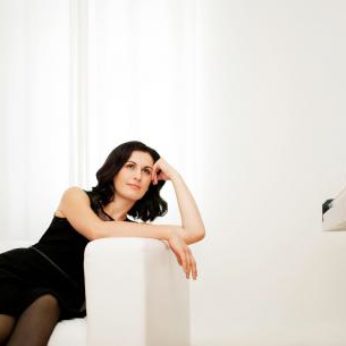Composer: Robert Schumann (b. 1810 - d. 1856)
Performance date: 02/07/2016
Venue: St. Brendan’s Church
Composition Year: 1836-8
Duration: 00:30:03
Recording Engineer: Richard McCullough, RTÉ lyric fm
Instrumentation: pf
Instrumentation Category:Solo
Artists:
Tamar Beraia -
[piano]

A verse from Schlegel stands at the head of
Schumann’s score. Roughly translated it reads: Through all the tones / in Earth’s many-coloured dream / there sounds
one soft and long-drawn note / for the ear of the secret listener. The
secret listener is of course Clara Wieck, for whom this impassioned musical
love-letter was written. When she first saw the score she was still only
seventeen and banished by her fearsome father to give a concert series in
Paris, in order to keep her away from Schumann.
Schumann was not the first composer to
write in code, but he took the idea to enormous lengths. He had known her as a
twelve-year-old child prodigy when her ferociously strict father was also his
teacher, and he had shared five-note themes with her and together they had made
ciphers and codes and musical jokes. She had premiered his Papillons, a mad tale from a masked ball turned into musical
gold-dust. So what is more natural, when, five years later, they were lovers
torn apart by a bitter and betrayed father that Schumann should speak to Clara
through his scores.
The first movement takes one of their
five-note codes and dramatises it in the most passionate way possible. The
thick chord clusters and suspensions pedalled over shimmers of running
semiquavers give it the aura of timelessness as the music takes fire on the
keyboard. And hidden there was another secret code, the theme from the last
song in Beethoven’s An die ferne Geliebte,
written when he, too, was wracked by an impossible love. Only in the coda does
the theme sing out clear and true for all to hear and to recognise.
The link to Beethoven carried another
message, for the work was being written as a fund-raiser for a monument to him
in Bonn. So by including Beethoven’s theme in his second subject, he emphasized
the work’s public connection to his hero, while also speaking unambiguously to
Clara. There is another level of complexity here as Schumann dedicated the work
to the great virtuoso himself, Franz Liszt. In other words Schumann commits
himself in this way to write a work that is worthy of both Liszt’s virtuosity
and Beethoven’s name. And he succeeded spectacularly for though he often had
difficulty in hiding the seams in his larger works, such was his ardour in this
rhapsodic first movement that exposition, development and recapitulation, like
the themes themselves, flow unchecked into each other. Moreover the development
brings a new idea out of the ferne
Geliebte theme, a grave C minor
episode headed Im Legendenton – In
the Style of a Legend.
The proud march that makes up the middle movement is
cast in E flat, Beethoven’s heroic key, and is structured as a sonata-rondo,
one of Beethoven’s favourite last movement solutions. However Schumann puts
this brave, outward-looking movement second and places his introspective slow
movement last. This profoundly beautiful meditation finds new ways to conceal
Clara’s theme in the texture of the quiet opening theme, while holding back his
more ardent feelings for the rhapsodic second subject. The structure is simple
with the exposition followed immediately by the recapitulation. The work
concludes with a coda derived from the second theme rising to one last surge of
emotion before sinking to rest in a tranquil C major.
Copyright © 2024 West Cork Music. All rights reserved.
Designed and developed by Matrix Internet